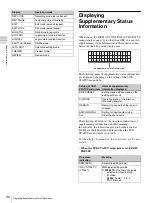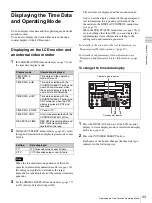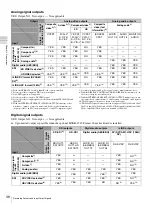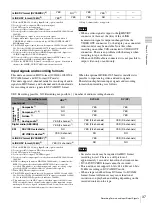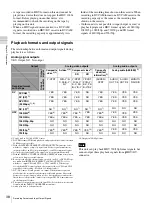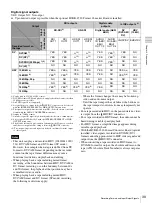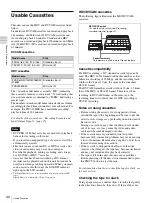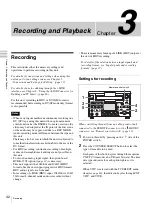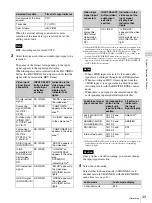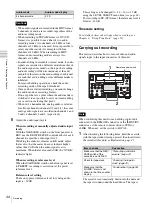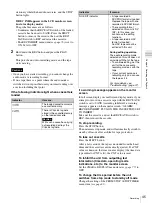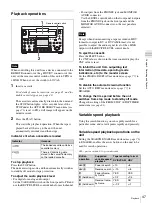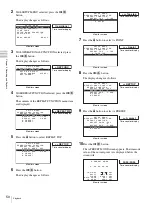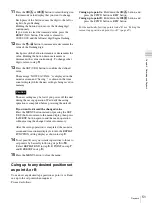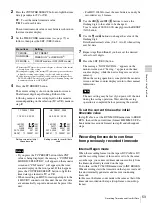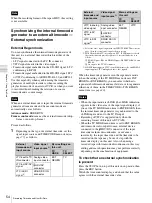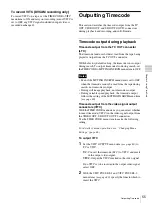
44
Recording
Ch
apt
er 3 Rec
o
rdi
ng and
P
la
y
bac
k
• When audio signals are recorded in the HDV format,
2 channels of audio are recorded, regardless of the
audio recording mode.
• When recording in DVCAM format or DV (SP)
format, it is possible to use either of two audio
recording modes: two channels at 48 kHz or four
channels at 32 kHz, can be used. It is not possible to
select any other mode (for example with four
channels at 48 kHz). When recording in HDV
format, audio recording mode is always two
channels at 48 kHz.
• In audio editing in assemble or insert mode, if audio
signals are recorded in a different mode from that of
the audio signals recorded on the tape, the resulting
audio recording will be discontinuous at the edit
points. For this reason, the menu settings on this unit
are such that audio editing across different modes is
inhibited.
For smooth editing operations, check the audio
recording mode of the tape beforehand.
• Once you have started recording, you cannot change
the audio mode or recording format.
• If on a tape there is a point where the audio mode is
switched, it is not possible to carry out insert editing
over a section including that point.
• When, in 4-channel mode, analog audio is selected
for all four channels (channels 1/2 and 3/4), the same
analog audio signals are recorded on channels 1 and
3 and on channels 2 and 4, respectively.
5
Adjust the audio input levels.
When recording at manually adjusted audio input
levels
With the VARIABLE switch on the front panel set to
REC, use the REC/PB LEVEL control knobs for each
channel to adjust the audio input level.
Watching the audio level meter in E-E mode, adjust
the level so that the meter does not indicate higher
values than 0 dB when the audio signal is at its
maximum. When the level exceeds 0 dB, the “OVER”
indicator lights.
When recording at reference level
When the VARIABLE switch on the front panel is set
to PRESET, recording is carried out at the preset
reference level.
Reference level setting
The factory-preset reference level for analog audio
input is –20 dB.
This setting can be changed to –18, –16 or –12 dB
using the LEVEL SELECT menu item
.
For recording in DV (SP) format, the reference level is
fixed at –12 dB.
Timecode setting
For details of timecode settings when recording, see
Chapter 4, “Using Time Data” (page 52).
Carrying out recording
This section describes how to record video and audio
signals input to the input connectors of this unit.
When controlling this unit from an editing control unit
connected to the REMOTE connector or the HDV/DV
connector, set the remote control switch to 9PIN or
i.LINK. When not, set the switch to LOCAL.
1
After checking the following items, hold the cassette
with the tape window facing upward, then insert it into
the recorder (this unit) as illustrated on
.
The cassette is automatically drawn into the unit and
the tape is wound round the head drum. The tape is
4-channel mode
32 K
Cautions
Audio mode
Audio mode display
Note
Item to check
See section
Make sure that the REC/
SAVE switch of the
cassette is set to REC.
“Preventing accidental
erasure” (page 41)
Check for tape slack.
“Checking the tape for
slack” (page 40)
Make sure that the
“HUMID!” alarm is not
shown in the time counter
display.
PRESET
VARIABLE
REC
PB
LEVEL
MONITOR
SELECT
COUNTER
SELECT
PHONES
CONTROL-S
REW
PLAY
F FWD
1
2
3
A
B
4
OVER
CH
1
0
-12
-20
-30
-40
-60
REC
STOP
TC
VITC
44.1K
OVER
REPEAT
1080 525
CH
2
EDIT MODE
REC INHI
EJECT
LOCAL
i.LINK
HDV DVCAM
(DV)
9PIN
01:23:45:15
REC/PB LEVEL
POWER
DISPLAY
MENU
RESET(NO)
SET(YES)
TC
PRESET
ASSIGN
CH1 1/2
CH2 3/4
INPUT SELECT
HD VIDEO
SD VIDEO
2
1
Remote control switch

